
The First and Only Weekly Online Fanzine Devoted to the Life and Works of Edgar Rice Burroughs |
 |

The First and Only Weekly Online Fanzine Devoted to the Life and Works of Edgar Rice Burroughs |
 |
A NEW EXPLORATION OF
THE TARZAN SERIES
BY EDGAR RICE BURROUGHS
Tarzan and the Ant Men II
The following essay first appeared in ERB-APA #58, Summer 1998
in a slightly different form.
A Lacanian Analysis of
Tarzan and the Ant Men
by Edgar Rice Burroughs
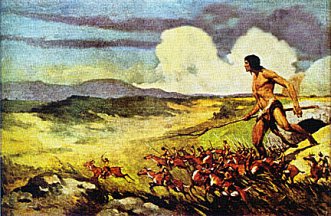
by
David Arthur Adams
Jacques Lacan wrote Ecrits I. Paris: Seuil, 1966 and Ecrits II. Paris: Seuil, 1971. They are texts of psychoanalytic theory which employ Freud's theories of condensation and displacement in dreams with a unique method of metaphor and metonymy in language.Lacan says that the unconscious is structured like language. Because language envelops everything we do and say we can apprehend the unconscious in dreams, jokes, and slips of the tongue. Literature as narration is language functioning as a higher level where connotation overrides denotation, where form obscures meaning, where ambiguity devalues message. Lacanian literary criticism restores the unconscious meaning lost in the narrative.
Title
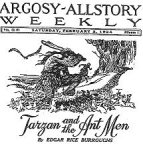 |
The title says a lot. Tarzan and the Ant Men may be read as "Tarzan and the Little Men," meaning reduced in size or in sexual potency. An "ant" man also gives way to the possibility of discourse upon the "littleness" of man's social institutions, political and/or religious, mundane or sacred, which are effectively lampooned in this novel. Man in his infancy may be read as a constant subtext throughout the entire work. |
Chapter 1 - A Girl is Raped by a Man
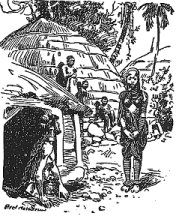 |
[Opens with a continuation of Tarzan and the Golden Lion]
Esteban Miranda, the false Tarzan double, is a prisoner of Obebe the cannibal. He is in possession of a bag of diamonds. He "befriends" Uhha, the daughter of Khamis the witch doctor, and she helps him escape. He forces her to accompany him into the jungle. |
Commentary
Esteban Miranda is an extremely complex character in the Tarzan novels. He is an alter-ego who embodies the shadow of the Tarzan's personality. He represents the dark opposite of every one of Tarzan's good and noble traits. He is the necessary Other who rounds out the character since Tarzan is portrayed by his creator as an ideal being. (A writer with more of a psychological bent would perhaps have explored his Tarzan character with a divided personality, but Burroughs' method usually consisted of creating another character to embody specific personality traits.)This novel begins in a strange place.
"In the filth of a dark hut, in the village of Obebe, the cannibal, upon the banks of the Ugogo, Esteban Miranda squatted upon his haunches and gnawed upon the remnants of a half-cooked fish."It is a fitting opening, for it sets the tone of the entire novel. The main male characters are captured in primitive, infantile states of being: Esteban is literally chained "like a dog" to a post. He must crawl about his narrow world. Tarzan reduced in size in the city of the Ant Men, and the son of the first woman is persecuted and driven by a group of larger, and superior women. Each of these male characters needs rescuing, each needs a resurrection of some kind from an infantile condition.The creeping (and creepy) Esteban is connected to a rusty chain by a slave collar (a sort of perverse reflection of Tarzan's locket). He has a great wealth of diamonds that he keeps hidden in a bag in his loin cloth (his sexuality wrapped in a diaper.) Uhha tells him if he a River Devil he could turn into a snake and crawl through the iron collar. (She can see his sexual potency.) He tells her that he does escape during the night time, but returns during the day.
The cannibal chief, Obebe holds the key to the collar in his own pouch. (His male sexual nature.) Uhha steals the brass key from Obebe. "At Obebe's side and half beneath his body she saw the chief's pouch." Too young, she is unaware of the sexual potency of the key. "She recognized it because it was the only thing the purpose of which she was not familiar with." The author here is almost stuttering. The psychological constraint of the moment is upon him, and his faulty sentence construction betrays his confusion.
Uhha takes the key to Esteban, who tries hard to keep from trembling. He fumbled with the key, his own sexuality in disuse, and later she opens the gate - - "showed him how the great bar could be withdrawn, and helped him push the gates open enough to permit him to pass through." Esteban takes her; abducts her, forcibly into the jungle. It is a veiled rape scene. The warriors (the other men) "slept in peaceful ignorance of the sudden tragedy that had entered the life of little Uhha."
Chapter Two - A Man is Raped by a Woman
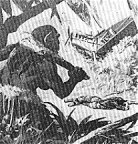 |
Tarzan flies an airplane into the jungle and crashes. He is captured by an ape-like woman who tears off his clothing. This "First Woman" clubs a Second Woman to keep her man-prize. A Third Woman then kills both The First Woman and The Second Woman. The Third Woman has captured a man whom she later carries off by the hair and rapes in her cave. |
Commentary
Tarzan is planning to "fly" but his son and daughter-in-law have doubts about his ability at his age. Tarzan says that the women in his life hold him back from sexual freedom. "If you and mother had your way my nerves and muscles would have atrophied long since. They were given me to use and I intend using them . . ."Even as Tarzan muses about his old age, a child bursts suddenly from the bungalow. "Muver," he cried, "Dakie doe? Dakie doe?" We assume this is Tarzan's grandchild named after his father, Korak-Jack. He is the very image of the state of infancy that will inform this novel. "Let him come along," urged Tarzan. Strangely, nothing more is said about the matter, not even an objection by his parents. The child also says, "Dare! Dackie do doe yalk!" foreshadowing the lack of language in the primitive Alalus.
Korak, Tarzan's son, suggests that he may try to fly all the way to London to see his wife, Jane, but Meriem, Korak's wife says, "he could never do it!" There is an estrangement between Tarzan and Jane that is a hidden undertow with many of his sexual encounters throughout the novel.
Tarzan flies off and sees a strange Great Thorn Forest, the symbol of the sexual ordeal he must pass through. His plane crashes, as the younger man and the younger woman feared. Tarzan is knocked unconscious, and is carried off by a cave-woman to a society where women dominate men. Tarzan is often knocked unconscious in the series, which denotes a movement from the real world into a world of fantasy. In this novel the fantasy consists of memories of infancy and fears of adult sexual impotency.
The three women present a very complex psychological situation. It is an ordeal for the hero, yet Tarzan is unconscious during the entire proceeding. That the women are not given names underscores their extremely primitive state of being, and the earliness of the psychological situation. The fact that Tarzan is unconscious places the occasion in very early infancy indeed.
The First Woman is obviously the mother of Tarzan, Kala. She was the first real female in his life since he was orphaned at such an early age. She brutally clubs another woman (The Second Woman) to keep her man-prize (and eventual sexual partner!). Tarzan is placed in a cave and stripped of all his clothing.
A Third Woman appears with a dead antelope and a living man. The first two woman attack her, and the First Woman is killed -- like Kala -- that is: The First Woman in his life is dead. The Second Woman is also killed by the Third Woman. She is first stopped from fleeing by sort of primitive sling-shot, a stone tied to a thong, and eventually clubbed to death.
The Second Woman may be read as Jane, but only as a veiled wish since she is still alive, and the Third Woman as the enormous threat of his own primitive sexuality that was never really answered by his wife alone. We can see this by the earlier comment about being held down to earth by his wife. "You wouldn't be doing this now if mother were here."
Chapter Three - The Boys Escape the Terrible Women
 |
The odyssey of the locket begins. A young man of the Alali takes it from the unconscious Tarzan's neck and puts it on his own. Tarzan wakes up and finds that the primitive people only speak with signs. |
Commentary
 |
By taking Tarzan's locket, the boy appropriates the symbol of Tarzan's
youth We may read his impotence and dependence upon the stronger women
as a picture an infantile state of being. (Later, Tarzan befriends one
of the boys, teaches him to use the bow and arrow as a weapon of sexual
potency, thus changing the condition of this primitive matriarchy to one
with a "normal" male dominance. "The hideous life of the Alalus was the
natural result of the unnatural reversal of sex dominance." There was no
"love" in this world. It was a "savage and perverted" condition.)
The condition of the Alali is so primitive that they only speak by signs. The lack of a spoken language underscores their infantile state. Tarzan is in a sort of play-pen with walls that he would like to climb over. The children let their parents know they are hungry by stamping their feet and pounding on the walls. The children decide to eat Tarzan, but he is defended by one of the bolder boys, the son of the First Woman. Tarzan and the boy escape by running away. |
Chapter Four
. . . To be continued . . .
AfterwordI have thought about this novel since 1995, and the two essays above show that I have tried to gain some understanding of the narrative through a variety of methods. Today I believe that another essay may be written in which the parallel stories of Esteban Miranda, the Alalus, and the Ant Men could be seen as reflections upon one another.
The little journey of Tarzan's locket is perhaps a key to the mystery, or perhaps it is only another conundrum that ERB planted in this complex narrative. The locket moves from Tarzan's unconscious neck to a primitive boy, who is killed. Next to Ska, the vulture, who is killed, then finally rests on the horns of a dead buffalo bull until the final chapter when it is given to Esteban Miranda, a completely insane false-Tarzan.
The entire novel reads like an extremely vivid dream, the same power which ERB manages to resurrect again in Tarzan at the Earth's Core. It seems that the best Tarzan novels present the ape-man wandering about at lose ends or in a state of amnesia. The strength of ERB's gesture is to present his jungle hero in this carefree, careless mood and mode. The very dreaminess elevates unreality to adventure; it numbs the critical senses, so that we believe in whatever Tarzan sees and does no matter how farfetched or outrageous it might seem to cool reason in the light of day.
P.J. Farmer in his Tarzan Alive would have none of the Ant Men excursion, calling it a satire, just as he threw Tarzan at the Earth's Core out of the canon as sheer fiction. It's interesting that he should pick these two as special cases -- ones that would not easily fit into his trope of Greystoke as a real man.
I think we might read Tarzan's many blows to the head, his many falls into an unconscious state, as a sign that ERB is moving his character from the everyday real to a kind of heightened reality. He moved John Carter to Barsoom with a kind of mental transportation, and I would suggest that Tarzan being knocked out (or simply falling asleep) signaled something in ERB's psyche that helped him to get into the mode of writing another good Tarzan novel.
I see Tarzan and the Ant Men as a slipping into his usual mode of writing Barsoomian novels. Tarzan even sword fights in this one. It is as close to a Tarzan on Mars that we got from the pen of the master. Coming after the gritty war novels, Tarzan is moved into some amazing fantasy worlds, some based upon historical places to be sure, but after Pal-ul-don, Africa was never the same Africa for Burroughs. It took war or the threat of war to bring Tarzan to the surface of a real world, just as it did for ERB himself. The rest of the time, it was fantasy land for him and for all of his characters -- jungle or desert planet, it was all the same -- places where death was a but dream for eternally youthful archetypes of love and adventure.
April 19, 2002
Tarzan and the Ant Men Cover Gallery
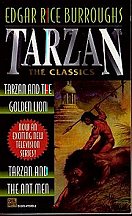
Visit
David "Nkima" Adams' ERBzin-e homepage
ERBzine
0396
to see the navigation chart of all of his
Chattering From the Shoulder columns
and other appearances in the Hillman ERB Cosmos
![]()
![]()
Volume
0796

BILL
HILLMAN
Visit
our thousands of other sites at:
BILL
AND SUE-ON HILLMAN ECLECTIC STUDIO
All
ERB Images© and Tarzan® are Copyright ERB, Inc.- All Rights Reserved.
All
Original Work © 1996-2002/2010 by Bill Hillman and/or Contributing
Authors/Owners
Chattering
from the Shoulder is a Copyrighted feature by David Adams